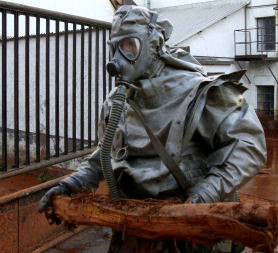Toxic sludge kills four in Hungary
A state of emergency has been declared in Hungary after a flood of toxic red sludge engulfed several towns killing at least four people.
Emergency workers wearing masks and chemical protection gear have been brought in to deal with the disaster.
It happened on Monday when a massive sludge reservoir burst its banks at an alumina plant in Ajka.
At least four people, including a toddler, are dead while six are missing and more than a hundred others are injured.
Many people suffered burns when the toxic red sludge went through their clothes.
Hundreds of residents have been evacuated and a state of emergency has been declared.
These shoes are the only thing I have left. I lost everything. Devecser resident
The torrent of toxic red sludge inundated homes in the town of Devecser, swept cars off roads and damaged bridges.
One thousand tonnes of plaster have been poured into the Marcal River in an attempt to bind the sludge and stop it flowing into the Danube around 45 miles away.

Some desperate villagers waded through the toxic red sludge in an attempt to salvage possessions: “These shoes are the only thing I have left. I lost everything and they don’t even let me go to my house”, said one Devecser resident.
One official described it as an “ecological disaster” that may threaten the Danube and other key rivers.
It is estimated that so far 35.3 million cubic feet of sludge has leaked from the reservoir affecting an estimated 15.4 square miles.
The toxic sludge is immensely corrosive
The toxic sludge that has engulfed the Hungarian villages of Kolontár, Devecser and Somlóvásárhely is like a flood of caustic soda, or drain cleaner, writes Science Correspondent Julian Rush. It is highly alkaline, with pH levels of up to 13 reported.
Just like caustic soda, it is immensely corrosive and burns the skin of anyone who comes into contact with it. It can cause painful irritation to eyes and lungs. It is more than powerful enough to kill everything in the rivers and watercourses it flows into, from fish to invertebrates.
Though there is likely to be some heavy metals in the sludge, its toxicity is of less concern than its corrosiveness.
The red colour comes from the iron hydroxide in the sludge, in the same way that iron compounds give our blood its red colour. Emergency teams are adding acid and gypsum plaster to the sludge to try to neutralise it, but even if that is successful, the red solid residue left behind, though probably relatively benign, will remain for years because the particles are so fine they are impossible to wash away.
Hungarian Prime Minister Viktor Orban acknowledged that the authorities were caught off guard by the disaster, telling reporters the alumina plant and reservoir had been inspected two weeks earlier and no irregularities had been found.
Red sludge is a by-product of the refining of bauxite into alumina, the basic material for manufacturing aluminium.
Representatives from industry organisations in London and the U.S could not explain why the Hungarian victims were burned by the material, saying if it is properly treated it is not hazardous.
It is common to store treated sludge in ponds where the water eventually evaporates, leaving behind a dried red clay-like soil, the officials said.
MAL Rt., the Hungarian Aluminium Production and Trade Company that owns the Ajka plant, said that according to European Union standards, red sludge is not considered hazardous waste.
The company also denied that it should have taken more precautions to shore up the reservoir, a huge structure more than 1,000 feet long and 500 yards wide, and high enough to dwarf trees that survived the torrent.
-
Latest news
-
Year of civil war in Sudan ‘a nightmare of hunger and displacement’4m

-
Israel fears repeat Iran attack, says former editor of Jerusalem Post4m

-
How long could it take to clear the Rwanda asylum seeker backlog?3m

-
Rwanda asylum boost for Sunak as bill expected to become law2m

-
Donald Trump trial: day one of historic Stormy Daniels court case4m

-




